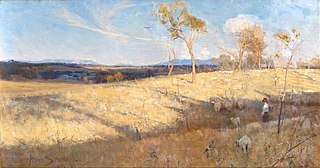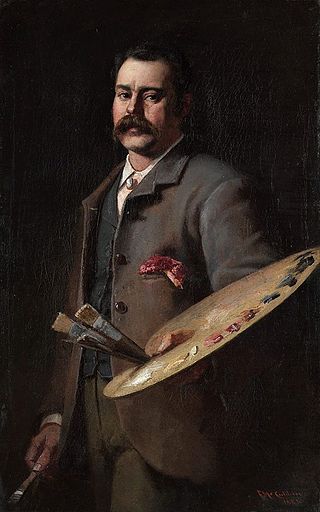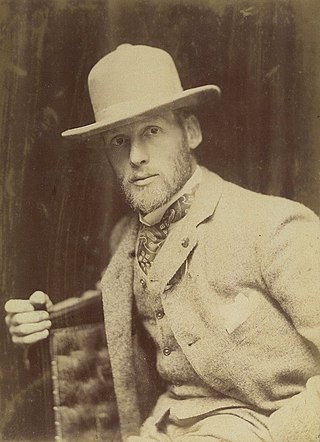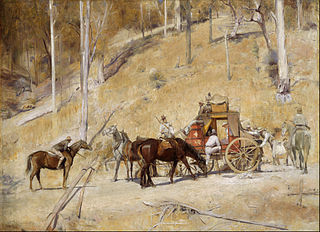
Bushrangers were originally escaped convicts in the early years of the British settlement of Australia who used the bush as a refuge to hide from the authorities. By the 1820s, the term had evolved to refer to those who took up "robbery under arms" as a way of life, using the bush as their base.

The National Gallery of Australia (NGA), formerly the Australian National Gallery, is the national art museum of Australia as well as one of the largest art museums in Australia, holding more than 166,000 works of art. Located in Canberra in the Australian Capital Territory, it was established in 1967 by the Australian Government as a national public art museum. As of 2022 it is under the directorship of Nick Mitzevich.

The Heidelberg School was an Australian art movement of the late 19th century. It has been described as Australian impressionism.

Frederick Wordsworth Ward, better known by the self-styled pseudonym of Captain Thunderbolt, was an Australian bushranger renowned for escaping from Cockatoo Island, and also for his reputation as the "gentleman bushranger" and his lengthy survival, being the longest-roaming bushranger in Australian history.

Frederick McCubbin was an Australian artist, art teacher and prominent member of the Heidelberg School art movement, also known as Australian impressionism.

Thomas William Roberts was an English-born Australian artist and a key member of the Heidelberg School art movement, also known as Australian impressionism.

Charles Edward Conder was an English-born painter, lithographer and designer. He emigrated to Australia and was a key figure in the Heidelberg School, arguably the beginning of a distinctively Australian tradition in Western art.

The Chandos portrait is the most famous of the portraits that are believed to depict William Shakespeare (1564–1616). Painted between 1600 and 1610, it may have served as the basis for the engraved portrait of Shakespeare used in the First Folio in 1623. It is named after the 3rd Duke of Chandos, who formerly owned the painting. The portrait was given to the National Portrait Gallery, London, on its foundation in 1856, and it is listed as the first work in its collection.

Sir Arthur Ernest Streeton was an Australian landscape painter and a leading member of the Heidelberg School, also known as Australian Impressionism.
Civilian is the pseudonym of Tom Civil a street artist, operating out of Melbourne, Australia, who has been profiled as a "leading player" of "the city's vibrant stencil art scene".

Walter Herbert Withers was an English-born Australian landscape artist and a member of the Heidelberg School of Australian impressionists.

Shearing the Rams is an 1890 painting by Australian artist Tom Roberts. It depicts sheep shearers plying their trade in a timber shearing shed. Distinctly Australian in character, the painting is a celebration of pastoral life and work, especially "strong, masculine labour", and recognises the role that the wool industry played in the development of the country.

Bailed Up is a 1895 painting by Australian artist Tom Roberts. The painting depicts a stage coach being held up by bushrangers in an isolated, forested section of a back road. The painting is part of the collection of the Art Gallery of New South Wales. and has been described by one former Senior Curator as "the greatest Australian landscape ever painted".

A break away! is an 1891 painting by Australian artist Tom Roberts.

A holiday at Mentone is an 1888 painting by Charles Conder, a leading member of the Heidelberg School movement, also known as Australian impressionism. It depicts people engaged in seaside activities on a sunny day at Mentone Beach, in the Melbourne suburb of Mentone.

Charcoal burners is a 1886 painting by the Australian artist Tom Roberts. The painting depicts three rural labourers "splitting and stacking timber for the preparation of charcoal". Roberts, influenced by the Barbizon school and Jules Bastien-Lepage, would later return to the theme of rural men working in his works A break away! and Shearing the Rams.

The Fall of Phaeton is a painting by the Flemish master Peter Paul Rubens, featuring the ancient Greek myth of Phaeton (Phaethon), a recurring theme in visual arts. Rubens chose to depict the myth at the height of its action, with the thunderbolts hurled by Zeus to the right. The thunderbolts provide the light contrast to facilitate the display of horror on the faces of Phaeton, the horses and other figures while preserving the darkness of the event. The butterfly winged female figures represent the hours and seasons, who react in terror as the night and day cycle becomes disrupted. The great astrological circle that arches the heavens is also disrupted. The assemblage of bodies form a diagonal oval in the center, separating dark and light sides of the canvas. The bodies are arranged so as to assist the viewer's travel continually around that oval.
Eileen Yaritja Stevens was an Aboriginal artist from central Australia. Although she had brief career of less than four years, she quickly became one of the most successful artists of her generation to paint in the style of the Western Desert. Her work is now held in several major public art collections across Australia.

Imperial Fritillaries in a Copper Vase is an oil painting on canvas created by the post-impressionist painter Vincent van Gogh in Paris, 1887. The painting is now part of the collection of the Musée d'Orsay in Paris, France. This work was made at a time of the life of Van Gogh when he first encountered influences from Impressionists and became aware of light and color, implementing it in his paintings. This painting presages some of his most famous subsequent works, and stands out from other still lifes because of the implementation of mixed techniques and complementary colors.
Long Jack Phillipus Tjakamarra, occasionally referred to as Kumantjayi Long Tjakamarra, was a Ngalia/Warlpiri man and a founding member of the Papunya Tula art cooperative. His contribution to the Honey Ant Dreaming mural would help define and catalyze the art style of the Western Desert Art Movement.


















